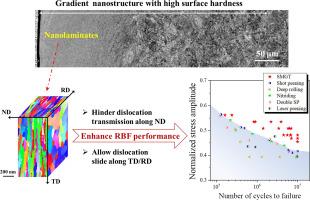具有各向异性梯度纳米结构表层的马氏体时效钢的旋转弯曲疲劳行为
IF 14.3
1区 材料科学
Q1 MATERIALS SCIENCE, MULTIDISCIPLINARY
引用次数: 0
摘要
表面改性是提高马氏体时效钢疲劳性能的必要手段,因为马氏体时效钢通常具有很高的表面缺口敏感性。在本研究中,通过表面机械磨削处理(SMGT),在18% Ni马氏体时效钢表面制备了具有纳米层状材料和各向异性力学性能的梯度微结构表面层。旋转弯曲疲劳试验表明,SMGT样品的疲劳性能得到了显著提高,其疲劳极限相对于接收样品提高了~ 31%。疲劳机理研究表明,疲劳性能的提高首先与梯度纳米结构表层强度和硬度的提高有关。同时,纳米层合材料的各向异性微观结构和力学性能对其在高应力幅值下的疲劳性能也起着决定性的作用。这是因为纳米层合材料不仅可以通过阻碍位错沿法向的传递来抑制表面缺陷的生长,还可以通过在疲劳过程中容纳位错沿滚动方向和横向方向的滑动来抑制微观组织中的损伤积累。本文章由计算机程序翻译,如有差异,请以英文原文为准。

Rotary bending fatigue behavior of maraging steel with an anisotropic gradient nanostructured surface layer
Surface modifications are imperative approaches to promote the fatigue performance of maraging steels, which typically possess high surface notch sensitivity. In this study, a gradient microstructured surface layer with nanolaminates and anisotropic mechanical properties was manufactured on an 18% Ni maraging steel by surface mechanical grinding treatment (SMGT). Rotary bending fatigue tests demonstrated that the fatigue performance of SMGT samples is significantly promoted, with an increase of ∼31% in the fatigue limit relative to as-received samples. Investigations of fatigue mechanisms indicated that the promoted fatigue performance is first related to the enhanced strength and hardness in the gradient nanostructured surface layer. Meanwhile, the anisotropic microstructure and mechanical properties of nanolaminates also play decisive roles in significantly enhancing the fatigue performance under high stress amplitudes. This is because the nanolaminates might not only suppress the growth of surface defects by hindering dislocation transmission along the normal direction, but also depress the damage accumulation in microstructure by accommodating dislocation slide along the rolling and transverse directions during fatigue.
求助全文
通过发布文献求助,成功后即可免费获取论文全文。
去求助
来源期刊

Journal of Materials Science & Technology
工程技术-材料科学:综合
CiteScore
20.00
自引率
11.00%
发文量
995
审稿时长
13 days
期刊介绍:
Journal of Materials Science & Technology strives to promote global collaboration in the field of materials science and technology. It primarily publishes original research papers, invited review articles, letters, research notes, and summaries of scientific achievements. The journal covers a wide range of materials science and technology topics, including metallic materials, inorganic nonmetallic materials, and composite materials.
 求助内容:
求助内容: 应助结果提醒方式:
应助结果提醒方式:


